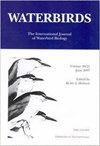Siberian Crane Migration: Individuals Repeat Timing and Route in Spring Migration
IF 0.6
4区 生物学
Q3 ORNITHOLOGY
引用次数: 1
Abstract
Abstract. Stopover habitats in long-distance migrants such as Siberian Cranes (Leucogeranus leucogeranus) are subject to dynamic changes, both seasonally and spatially. Due to the difficulty in conserving stopover habitats across vast geographies, it is necessary to clarify the timing and route patterns of stopover sites in order to take practical measures to protect habitats. From 2014 to 2018, we successfully tracked n = 10 Siberian Cranes by satellite tracking and obtained data for n = 26 complete migrations. We obtained the annual cycle of cranes and analyzed the repeatability between seasons and individuals. According to tracking data, Siberian Cranes started and ended autumn migration on 23 September and 19 November, respectively. Spring migration started on 8 April and ended on 4 June. The migration routes between seasons showed spatial similarity but less repeatability. There is significant repeatability in migration routes from 48°N to 58°N (Russian areas) between individuals in spring. Our results provide support for some seasonal plasticity in the timing of migration and flexibility in routes taken by migrating Siberian Cranes. Other than rigid patrol and guardianship for the entire spring, we also propose strengthening monitoring and protection in the identified stopover areas from the end of March to the beginning of May each year.西伯利亚鹤的迁徙:春季迁徙中个体重复的时间和路线
摘要西伯利亚鹤(Leucogeranus Leucogeranus)等长途候鸟的中途停留栖息地受到季节和空间动态变化的影响。由于大地域的中途停留栖息地保护困难,有必要明确中途停留点的时间和路线模式,以便采取切实可行的措施来保护栖息地。2014 - 2018年,利用卫星跟踪技术成功跟踪了n = 10只西伯利亚鹤,获得了n = 26次完整迁徙数据。我们得到了鹤的年周期,并分析了季节和个体之间的重复性。追踪资料显示,白鹤秋季迁徙分别于9月23日和11月19日开始和结束。春季迁徙于4月8日开始,6月4日结束。季节间迁徙路线具有空间相似性,但重复性较差。春季个体间从48°N到58°N(俄罗斯地区)的迁徙路线具有显著的重复性。我们的研究结果为西伯利亚鹤迁徙时间的季节性可塑性和迁徙路线的灵活性提供了支持。除了整个春季的严格巡逻和监护外,我们还建议在每年3月底至5月初加强对确定的中途停留区域的监测和保护。
本文章由计算机程序翻译,如有差异,请以英文原文为准。
求助全文
约1分钟内获得全文
求助全文
来源期刊

Waterbirds
生物-鸟类学
CiteScore
1.30
自引率
0.00%
发文量
0
审稿时长
6-12 weeks
期刊介绍:
Waterbirds is an international scientific journal of the Waterbird Society. The journal is published four times a year (March, June, September and December) and specializes in the biology, abundance, ecology, management and conservation of all waterbird species living in marine, estuarine and freshwater habitats. Waterbirds welcomes submission of scientific articles and notes containing the results of original studies worldwide, unsolicited critical commentary and reviews of appropriate topics.
 求助内容:
求助内容: 应助结果提醒方式:
应助结果提醒方式:


